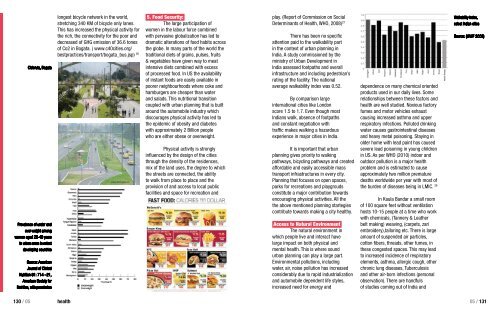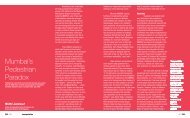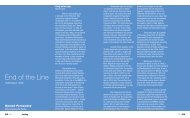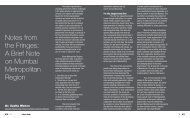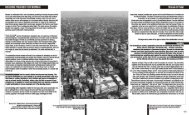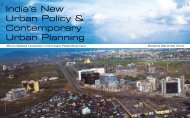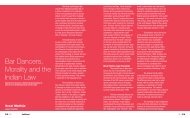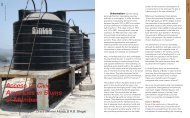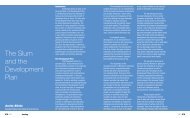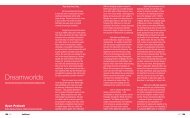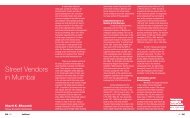Cicloruta, BogataPrevalence <strong>of</strong> under andover-weight amongwomen aged 20-49 yearsin urban areas in selectdeveloping countriesSource: AmericanJournal <strong>of</strong> ClinicalNutrition 81: 714 –21,American Society forNutrition, with permissionlongest bicycle network in <strong>the</strong> world,stretching 340 KM <strong>of</strong> bicycle only lanes.This has increased <strong>the</strong> physical activity for<strong>the</strong> rich, <strong>the</strong> connectivity for <strong>the</strong> poor anddecreased <strong>of</strong> GHG emission <strong>of</strong> 36.6 tones<strong>of</strong> Co2 in Bogata. ( www.c40cities.org/bestpractices/transport/bogata_bus.jsp) 265. Food Security:The large participation <strong>of</strong>women in <strong>the</strong> labour force combinedwith pervasive globalization has led todramatic alterations <strong>of</strong> food habits across<strong>the</strong> globe. In many parts <strong>of</strong> <strong>the</strong> world <strong>the</strong>traditional diets <strong>of</strong> grains, pulses, fruits& vegetables have given way to meatintensive diets combined with excess<strong>of</strong> processed food. In US <strong>the</strong> availability<strong>of</strong> instant foods are easily available inpoorer neighbourhoods where coke andhamburgers are cheaper than waterand salads. This nutritional transitioncoupled with urban planning that is builtaround <strong>the</strong> automobile industry whichdiscourages physical activity has led to<strong>the</strong> epidemic <strong>of</strong> obesity and diabeteswith approximately 2 Billion peoplewho are ei<strong>the</strong>r obese or overweight.Physical activity is stronglyinfluenced by <strong>the</strong> design <strong>of</strong> <strong>the</strong> citiesthrough <strong>the</strong> density <strong>of</strong> <strong>the</strong> residences,mix <strong>of</strong> <strong>the</strong> land uses, <strong>the</strong> degree to which<strong>the</strong> streets are connected, <strong>the</strong> abilityto walk from place to place and <strong>the</strong>provision <strong>of</strong> and access to local publicfacilities and space for recreation andplay. (Report <strong>of</strong> Commission on SocialDeterminants <strong>of</strong> <strong>Health</strong>, WHO, 2008) 27There has been no specificattention paid to <strong>the</strong> walkability partin <strong>the</strong> context <strong>of</strong> urban planning inIndia. A study commissioned by <strong>the</strong>ministry <strong>of</strong> <strong>Urban</strong> Development inIndia assessed footpaths and overallinfrastructure and including pedestrian’srating <strong>of</strong> <strong>the</strong> facility. The nationalaverage walkability index was 0.52.By comparison largeinternational cities like Londonscore 1.5 to 1.7. Even though mostIndians walk, absence <strong>of</strong> footpathsand constant negotiation withtraffic makes walking a hazardousexperience in major cities in India.It is important that urbanplanning gives priority to walkingpathways, bicycling pathways and createdaffordable and easily accessible masstransport infrastructures in every city.Planning that focuses on open spaces,parks for recreations and playgroudsconstitute a major contribution towardsencouraging physical activities. All <strong>the</strong><strong>the</strong> above mentioned planning startegiescontribute towards making a city healthy.Access to Natural EnvironmentThe natural environment inwhich people live and interact havelarge impact on both physical andmental health. This is where soundurban planning can play a large part.Environmental pollutions, includingwater, air, noise pollution has increasedconsiderably due to rapid industrializationand automobile dependent life styles,increased need for energy anddependence on many chemical orientedproducts used in our daily lives. Somerelationships between <strong>the</strong>se factors andhealth are well studied. Noxious factoryfumes and motor vehicles exhaustcausing increased asthma and upperrespiratory infections. Polluted drinkingwater causes gastrointestinal diseasesand heavy metal poisoning. Staying inolder home with lead paint has causedsevere lead poisoning in young childrenin US. As per WHO (2010) indoor andoutdoor pollution is a major healthproblem and is estimated to causeapproximately two million prematuredeaths worldwide per year with most <strong>of</strong><strong>the</strong> burden <strong>of</strong> diseases being in LMIC. 28In Kaula Bandar a small room<strong>of</strong> 100 square feet without ventilationhosts 10-15 people at a time who workwith chemicals, (Tannery & Lea<strong>the</strong>rbelt making) weaving, (carpets, zariembroidery),tailoring etc. There is largeamount <strong>of</strong> suspended air particles,cotton fibers, threads, o<strong>the</strong>r fumes, in<strong>the</strong>se congested spaces. This may leadto increased incidence <strong>of</strong> respiratoryelements, asthma, allergic cough, o<strong>the</strong>rchronic lung diseases, Tuberculosisand o<strong>the</strong>r air-born infections (personalobservation). There are handfuls<strong>of</strong> studies coming out <strong>of</strong> India andWalkability index,select Indian citiesSource: (WWF 2008)130 / 05 health05 / 131
Pakistan that has looked at <strong>the</strong>se butmore empirical research is needed toestablish <strong>the</strong> causal pathways in a morerigorous manner. In addition in KB wehave observed continuous flooding <strong>of</strong> <strong>the</strong>homes during monsoons, thus giving riseto large number <strong>of</strong> vector born diseases.Ano<strong>the</strong>r critical part <strong>of</strong> urbandesign related to <strong>the</strong> <strong>Urban</strong> Heat Islandeffect secondary to climate change.The absorption <strong>of</strong> heat by <strong>the</strong> concretesurfaces results in urban areas havinghigher temperatures than surroundingnon-urban areas (GRNUHE 2010). Thisindeed has a negative impact on <strong>the</strong>health. Therefore ensuring trees, openparks, greenery as a part <strong>of</strong> urbanplanning will provide both cool shade andcarbon sinking capacity to <strong>the</strong> cities<strong>Health</strong>y by <strong>Design</strong>A planners’ guide toenvironments for active living wasreleased by <strong>the</strong> National Heart Foundation<strong>of</strong> Australia (Victorian Division) in 2004.The development <strong>of</strong> <strong>Health</strong>y by <strong>Design</strong>was assisted by key stakeholdersrepresenting planning, recreation, health,transport and community buildingsectors and with support from <strong>the</strong>Planning Institute, Australia - VictoriaDivision. This design tool has beenwidely adopted by local governmentand developers in Victoria, Australia.(Su<strong>the</strong>rland & Carlisle,2004) 29Key <strong>Health</strong> Objective for <strong>Urban</strong> Planners:<strong>Urban</strong> Planning policies and proposalshould encourage <strong>the</strong> following:1. <strong>Health</strong>y exercise2. Social cohesion3. Housing quality4. Access to employment opportunity5. Local low impact foodproduction and distribution6. Community and road safety7. Equity & reduction <strong>of</strong> poverty8. Good air quality andprotection from noise9. Good water & sanitation quality10. Conservation anddecontamination <strong>of</strong> land11. Climate stabilityConclusions<strong>Urban</strong> planning and designhas a large and critical role to play increating healthy cities by providingcreative and equitable urban builtform. Through <strong>the</strong> medium <strong>of</strong> physicalenvironment <strong>the</strong> urban planners canenhance <strong>the</strong> physical, mental and socialhealth <strong>of</strong> <strong>the</strong> communities. This canbe achieved through various maens.From land use patterns, mixed zoningpatterns, good connectivity, affordableand effective transport mechanisms,low cost housing, and accessibility toall advantages <strong>of</strong> urbanization. Buildinghealth equity through design and thusbuilding healthy and wealthy citiesshould become a major goal <strong>of</strong> <strong>the</strong>urban planning and design processes.Bibliography1UN Habitat 2009, “Planning sustainable cities: Global report on human settlements 2009, Nairobi.2Corburn, J (2004): “Confronting <strong>the</strong> challenges in reconnecting <strong>the</strong> urbanplanning and public health” Am J Public <strong>Health</strong> 94 ($) 541‐5493Slone, D (2006) From congestion to sprawl: planning and health in historical context Jam Plann Assoc 72 (1) 10‐184Boarnet MG: Journal <strong>of</strong> American Planning Association. (2006) Volume 72, issue 15Hancock, T and Duhl L (1986): <strong>Health</strong>y Cities: promoting <strong>Health</strong> in <strong>Urban</strong> Context.Copenhagen, WHO Regional Office for Europe6<strong>Health</strong>y <strong>Urban</strong> Planning in practice: experince <strong>of</strong> European Cities. Report <strong>of</strong> <strong>the</strong> WHO<strong>City</strong> Action Group on <strong>Health</strong>y <strong>Urban</strong> Planning. Edited by Hugh Barton, ClaireMitcham, Ca<strong>the</strong>rine Tsouros.7UN Habitat 2008-2009: State <strong>of</strong> <strong>the</strong> World Cities, Harmonious Cities, Nairobi,United Nations Settlement Programme8UNFPA 2007: State <strong>of</strong> <strong>the</strong> world population: Unleashing <strong>the</strong> <strong>Urban</strong> Growth.9UN Habitat 2006: State <strong>of</strong> <strong>the</strong> world cities 2006/7. The Millennium development goalsand urban sustainability. Nairobi, United Nations Settlement Programme10UN Habitat 2009: Planning sustainable cities: Global report on humansettlements. Nairobi, United Nations Settlement Programme11UN Habitat 2010: State <strong>of</strong> <strong>the</strong> world cities 2010-2011. Cities for All: Bridging <strong>the</strong> <strong>Urban</strong> Divide. Nairobi, UN Habitat.12Vlahov et al (2007) “<strong>Urban</strong> as a Determinant <strong>of</strong> <strong>Health</strong>” Journal <strong>of</strong> <strong>Urban</strong> <strong>Health</strong>84 (0) 16-2613Satterthwaite D (2004): Under-estimation <strong>of</strong> <strong>Urban</strong> Poverty in Low and Middleincome Nations. HumanSettlements Working Paper Series. Poverty Reduction in <strong>Urban</strong> Areas No. 14. IIED, London.14KNUS: (www.who.int/social_determinants/resources/knus_final_report_052008.pdf15Galea, S, Freudenberg. N. and Vlahov, D (2005) “ Cities & population <strong>Health</strong>” Soc.sci. med. 60: 1017-103316Barton, H and Tsourou, C (2000) <strong>Health</strong>y <strong>Urban</strong> Planning: A WHO Guide to planning for people. London, WHO.17S. Parasuraman, <strong>Urban</strong> India: Understanding <strong>the</strong> maximum city: Uncovering <strong>the</strong> myth <strong>of</strong>urban development in Mumbai. <strong>Urban</strong> Age: India newspaper. November 2009 2118Campbell, et al. “ Ambulance arrival to pateinet contact: <strong>the</strong> hidden comonant <strong>of</strong>prehospital respons time intervals” Ann Emerg. Med. 22: 1254-125719Thomson, H Petticrew, M (2007): “Housing & <strong>Health</strong>” British Medical Journal, Vol. 334, Number 7591, 334-434.20GRNUHE, “ Improving <strong>Urban</strong> <strong>Health</strong> Equity through action on <strong>the</strong> social and environmentaldeterminants <strong>of</strong> health” Final Report to Rockefeller Foundation, 201021Lesser, A. Sawant, K. March 2010. “ <strong>Urban</strong> Environmental Determinants <strong>of</strong> <strong>Health</strong> in Mumbai:A case study <strong>of</strong> Kaula Bandar slum”. PUKAR-HSPH-NYU Project: Unpublished data.23WHO 2008: The global burden <strong>of</strong> disease: 2004 update24www.worldmapper.org/25WHO 2002: World report on Voilence & <strong>Health</strong>.26(www.c40cities.org/bestpractices/transport/bogata_bus.jsp)27Closing <strong>the</strong> gap in a generation: <strong>Health</strong> equity through action on social determinants <strong>of</strong>health. Report <strong>of</strong> Commission on Social Determinants <strong>of</strong> <strong>Health</strong>, WHO, 200828WHO 2010 “ Air Quality and <strong>Health</strong>” Kobe, WHO centre for <strong>Health</strong> development.29Su<strong>the</strong>rland, E. Carlisle R. NSW Public <strong>Health</strong> Bulletin, Vol. 18(12‐13) 228‐231132 / 05 health<strong>Anita</strong> <strong>Patil</strong> 05 / 133


